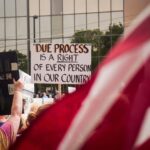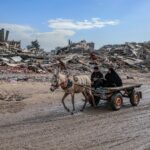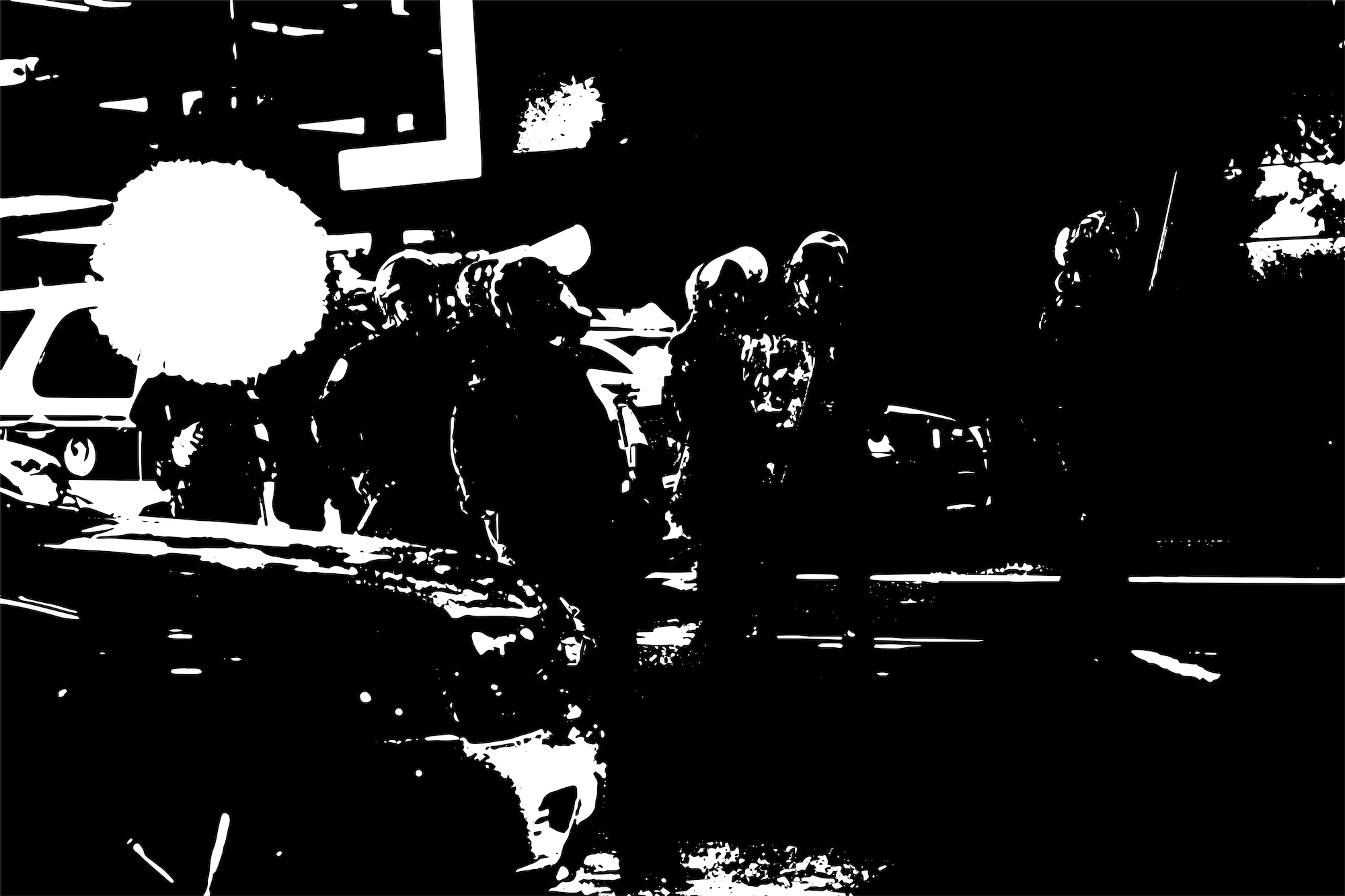Another Black body lay face down on the ground.
This was the image shown at the end of the video where 26-year-old Patrick Lyoya was gunned down in the streets at the hands of the Grand Rapids Police Department. In an act of radical transparency, the Grand Rapids police chief released the footage of the officer-involved shooting. I cannot bring myself to watch another video of Black death, but the descriptions, scenarios, and commentary alone bring back chilling memories of murders throughout history, most recently of George Floyd and the subsequent deaths that followed in the summer of 2020 and beyond. Lyoya’s murder, moreover, happened the same week the world found out that no charges would be filed in the murder of Amir Locke, who was shot by a police officer in Minneapolis.
In the first four months of 2022, the police killed 145 people in the United States. These are not isolated incidents. Rather, they are chapters in a lengthy novel that tells the story of the surveillance, securing, and force used on Black bodies in the name of “safety and security” in America. While this story is a long one, many believed that with this new administration and a heightened understanding of the need for social and racial justice, this time would be different. Unfortunately, for the moment, they are wrong. As a response to organizers, activists, and ordinary people calling for a systemic reimaging of what safety and security look like through tactics like “defunding the police,” President Joe Biden declared during his State of the Union address, “We should all agree, the answer is not to defund the police. The answer is to fund the police. Fund them. Fund them!” While this statement was disheartening, it was not shocking.
The sentiments reflected in the State of the Union align with the investment Biden has made in traditional forms of “security” and militarization. The core of this investment lies with the president’s proposed budget for defense spending. Despite his “diplomacy first” mantra, Biden has proposed the US spend $813 billion on defense in fiscal 2022. There is a multitude of reasons why this bloated budget is problematic. Still, when reflecting on this administration’s “commitment to equity and racial justice,” I can’t help but think about the negative ramifications this budget will have on the safety and security of Black and brown communities.
A TENUOUS RELATIONSHIP
Rooted in systemic oppression and surveillance, the relationship between law enforcement agencies and Black and brown communities has reflected a racialized hierarchy that has never positively benefited these communities. Moreover, as a consequence of the “forever wars” on drugs, crime, and terror, the relationship has further frayed. This systemic militarization has created a culture that centers violent conflict, and increases in our military budget, along with policies that support the militarization of the police, have fueled and inflated this problematic culture.
We can’t turn a blind eye to the ways our systems of militarization are killing people both at home and abroad. It’s not just the weapons; it’s the culture.
In the 1990s, policies like H.R. 3230 section 1033 set a standard for militarizing the police. This policy enacted by President Bill Clinton “allows the secretary of defense to sell or trade excess military equipment to local LEAs (law enforcement agencies).” Since its inception in 1996, 10,000 jurisdictions have received more than $7 billion of equipment, including rifles, tanks, military helmets, and other weapons. These weapons have been used in police raids and SWAT missions — and against protestors, including recent racial justice protests. Most notably, there is evidence that 1033 transfers are linked to the increased numbers of police killings every year. While President Barack Obama reflected on the ramifications of 1033 and made changes to the policy in the wake of the 2015 Ferguson protests — including stopping the transfer of “tanks and other tracked armored vehicles, weaponized aircraft and vehicles, firearms and ammunition measuring .50-caliber and larger, grenade launchers and bayonets” — Trump re-invoked these changes, restoring 1033 to its most harmful form.
There is no question of a correlation between the amount spent on the defense budget and policies like 1033. Therefore, when analyzing Biden’s proposed budget, it’s alarming to think about the ramifications of his budgetary increase on the safety and security of communities affected by 1033 moving forward. Fellow Democrats, including Reps. Pramila Jayapal (D-Wash.) and Barbara Lee (D-Calif) have noted the problematic nature of the fact that the United States already spends “$1 trillion in endless wars, mass incarceration, policing, immigration, and border enforcement.” Biden has doubled down on the need for increased military spending in the wake of Russia’s invasion of Ukraine. As Tupac said, “They got money for war but can’t feed the poor.” The problem is that defense spending won’t just affect those abroad. One of the first places it will affect is here at home, particularly in disenfranchised Black and brown communities where this administration has promised to make positive impacts in the form of racial equity and social justice.
While the current budget has line items for social safety, including childcare, climate, housing, and more, they pale when compared to the investments made for the military and militarization of our law enforcement agencies. A year ago, Sen. Bernie Sanders (D-Vt.) reflected, “At a time when the US already spends more on the military than the next 12 nations combined, it is time for us to take a serious look at the massive cost overruns, the waste and fraud that currently exists at the Pentagon.” Yet, nothing has changed.
Resources have been withheld from Black and brown communities because militarized policing and intervention at home — and abroad — have been deemed more important than issues like police reform, racial equity, and socio-economic justice. At home, the most grievous civil liberty and human rights atrocities, including mass incarceration, police killings, and the Muslim Ban, are linked to investments in 1033 and the militarization of the police. Similarly, drones strikes and killings broad — all forms of policing across the global color line — are also linked to 1033 and a militarized US foreign policy. Furthermore, the impact of 1033 is felt throughout American society. For example, many areas of public education in the United States are underfunded but thanks to 1033, there has been an increase in military-grade weaponry used by law enforcement agencies in K-12 schools. These weapons are being used to police, surveil, and punish children in Black and brown communities. And despite an ongoing global pandemic, this administration’s investment in military spending far exceeds that of our healthcare needs.
IT’S NOT JUST THE WEAPONS…
When I reflect on my frustration with this administration’s budget and its potential ramifications, I realize that my anger stems from the inability of policymakers and politicians to understand that most communities — especially the most disenfranchised communities in our country — do not equate safety and security with increased military spending. For communities that are constantly surveilled and policed, this spending reinforces their trauma. These weapons also do not provide the police the ability to provide security effectively. For example, last week, the New York Police Department, which has a $10 billion budget and is the 24th largest military spender in the world, was unable to keep its community safe from an active shooter, despite all the weaponry and “resources” it has at its disposal.
There must be a moral shift in how we view our country’s safety and security. An investment in military action and weapons can’t be the only way to keep people safe. We can’t turn a blind eye to the ways our systems of militarization are killing people both at home and abroad. It’s not just the weapons; it’s the culture. Suppose Biden and his administration are serious about creating equity and working for racial and social justice. In that case, they must shift this budget to be less reflective of warfare and more reflective of social care.
Stop investing in militarization and start investing in social structures that will make stronger communities. We have to find the humanity in our security or more communities will suffer.
Mari Faines (she/her) is a social justice, diversity & equity activist, podcast host, and currently the Partner for Mobilization at Global Zero. Her work specializes in nuclear intersectionality, conflict resolution, transitional justice, and racial and systemic disparities.




















